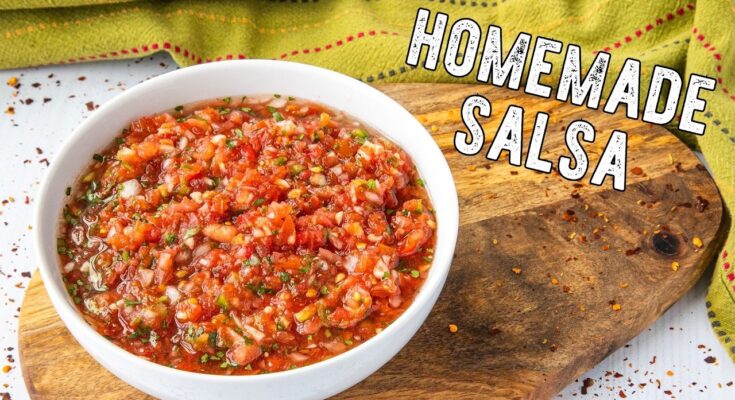Fresh Salsa Recipe: Fresh salsa is a game-changer in any kitchen. Unlike the store-bought versions, which often come loaded with preservatives, homemade salsa is all about vibrant flavors, fresh ingredients, and complete control over the spice level. Whether you’re hosting a party or simply upgrading your weekday meals, fresh salsa is a versatile condiment that pairs beautifully with chips, tacos, grilled meats, and even eggs. Plus, it’s quick and easy to make! Let’s dive into the steps to create your own fresh salsa masterpiece.
Ingredients Overview
To make the perfect fresh salsa, you’ll need a handful of simple ingredients:
- Tomatoes (4-6 medium ripe ones, such as Roma or vine-ripened)
- Onion (1 medium, preferably red or white)
- Cilantro (a handful of fresh leaves, finely chopped)
- Garlic (2-3 cloves, minced)
- Peppers (1-2 jalapeños or serranos, depending on your spice preference)
- Lime Juice (from 1 fresh lime)
- Salt and Pepper (to taste)
Optional ingredients for added flair:
- Sweet corn or black beans
- Diced avocado for a creamy touch
- Mango or pineapple for a fruity twist
Fresh ingredients are key to a bright and flavorful salsa, so try to source the best quality produce you can find.
Choosing the Right Tomatoes
Not all tomatoes are created equal when it comes to salsa. For a fresh and juicy salsa, opt for Roma tomatoes or vine-ripened tomatoes, as they have a dense, meaty texture and less water content, ensuring your salsa doesn’t turn out soupy. If you’re in a pinch, you can use canned diced tomatoes, but fresh is always preferred for authentic flavor.
Pro tip: Remove the seeds and watery pulp from the tomatoes for a thicker salsa, especially if you plan to serve it chunky.
The Role of Fresh Herbs
Fresh herbs like cilantro are the soul of any salsa recipe. It adds a burst of herbal brightness that complements the tomatoes and peppers perfectly. If you’re one of the few who dislike cilantro, don’t worry—you can substitute it with fresh parsley or green onions for a similar pop of freshness.
Chop your herbs finely to ensure even distribution of flavor throughout the salsa. It’s a small detail, but it makes all the difference.
Selecting the Perfect Peppers
Peppers are the heartbeat of your salsa, providing both flavor and heat. For a mild salsa, stick to jalapeños, removing the seeds and white ribs inside. If you prefer a spicier kick, go for serrano peppers or even habaneros if you’re feeling bold.
When handling hot peppers, wear gloves or wash your hands thoroughly afterward to avoid any unwanted heat on your skin or eyes. Trust me, you don’t want to skip this step!
Balancing the Flavors
Creating a perfect salsa is all about finding the right balance of flavors. Your salsa should be a harmonious blend of acidity, sweetness, saltiness, and heat.
- Acidity: Lime juice is essential for brightening the salsa and balancing the richness of the tomatoes. Use the juice of one lime to start, and adjust to taste. For an extra zing, you can also add a splash of vinegar.
- Sweetness: If your tomatoes are slightly underripe or tart, adding a pinch of sugar can help balance the flavors without overpowering the freshness.
- Salt: Don’t underestimate the role of salt! It enhances all the other flavors in the salsa. Start with ½ teaspoon and adjust as needed.
Pro Tip: Taste your salsa after each adjustment. This step is critical for crafting a well-balanced salsa that suits your taste buds perfectly.
Step-by-Step Guide to Preparing Salsa
- Prep the Ingredients:
- Dice the tomatoes finely, removing seeds for a less watery salsa.
- Chop the onion into small pieces for an even distribution of flavor.
- Mince the garlic cloves for a pungent kick.
- De-seed and finely dice the peppers for controlled heat.
- Chop the cilantro leaves, avoiding the stems for a smoother texture.
- Combine the Ingredients:
- In a large mixing bowl, combine the tomatoes, onion, garlic, peppers, and cilantro.
- Squeeze in the fresh lime juice and sprinkle salt over the top.
- Mix Thoroughly:
- Stir the ingredients well until all components are evenly mixed.
- Taste and Adjust:
- Taste your salsa and adjust the salt, lime juice, or peppers to match your desired flavor profile.
Blending vs. Chunky Salsa
One of the great things about salsa is its versatility in texture. Some prefer a smooth, blended salsa, while others love the rustic appeal of a chunky version.
- Blended Salsa: Use a food processor or blender for a smooth consistency. This is especially good if you want a dip-like texture for tortilla chips.
- Chunky Salsa: Hand-chopping all ingredients keeps the salsa hearty and rustic, making it perfect as a topping for tacos or grilled meats.
Pro Tip: If blending, pulse the ingredients gently to avoid over-processing, which can turn your salsa into soup.
Adjusting Heat Levels
The beauty of homemade salsa is that you can customize the spiciness to suit your palate.
- For Mild Salsa:
- Stick to one jalapeño and remove all the seeds and ribs.
- For Medium Heat:
- Use two jalapeños or substitute one with a serrano pepper.
- For Spicy Salsa:
- Add a combination of serrano and habanero peppers. You can even include some chili powder for an extra kick.
Tip: If your salsa turns out too spicy, tone it down by adding more diced tomatoes, a bit of sugar, or even a dollop of plain yogurt.
Chilling the Salsa for Best Flavor
While fresh salsa is delicious right away, letting it chill in the refrigerator for at least 30 minutes allows the flavors to meld together beautifully. This resting time enhances the taste and texture, making the salsa even more vibrant and irresistible.
Serving Suggestions
Fresh salsa is a versatile condiment that can elevate countless dishes. Here are some creative ways to serve and enjoy your homemade salsa:
- Classic Pairing with Chips:
- Serve your salsa as a dip alongside crispy tortilla chips. It’s a party favorite and perfect for casual snacking.
- Taco Topping:
- Spoon fresh salsa over tacos to add a burst of flavor and freshness. It works beautifully with beef, chicken, fish, or vegetarian fillings.
- Grilled Meats and Seafood:
- Use salsa as a topping for grilled chicken, steak, or fish. The tangy acidity complements smoky, charred flavors perfectly.
- Egg Dishes:
- Add a dollop of salsa to scrambled eggs, omelets, or breakfast burritos for a zesty morning boost.
- Salad Dressing or Garnish:
- Mix your salsa with a bit of olive oil to create a quick salad dressing, or use it as a garnish for grain bowls and salads.
- Creative Uses:
- Stir fresh salsa into soups or stews for added flavor.
- Use it as a pizza topping for a unique twist.
- Mix it with sour cream or guacamole for a layered dip.
Storage Tips
To maintain the freshness and quality of your salsa, proper storage is key:
- Refrigeration: Store your salsa in an airtight container in the refrigerator. Fresh salsa will stay good for 3-5 days, though it’s best enjoyed within the first 48 hours.
- Freezing: While fresh salsa is best enjoyed fresh, you can freeze it for longer storage. Place the salsa in a freezer-safe container, leaving some space for expansion. When ready to use, thaw it in the refrigerator and stir well before serving. Note that the texture may change slightly.
- Pro Tip: Always use a clean spoon when scooping salsa from the container to avoid contamination and extend its shelf life.
Variations on Fresh Salsa
Take your salsa game to the next level with these fun and flavorful variations:
- Fruit-Infused Salsas: Add diced mango, pineapple, or peaches to create a sweet and tangy salsa that pairs beautifully with grilled seafood or chicken.
- Roasted Salsa: Roast the tomatoes, peppers, garlic, and onion before blending. This imparts a smoky, deep flavor that’s irresistible.
- Corn and Black Bean Salsa: Mix in cooked sweet corn and black beans for a hearty and colorful variation that works great as a side dish.
- Avocado Salsa: Add chunks of creamy avocado for a richer and more luxurious salsa. This version is perfect as a topping for burrito bowls.
Common Mistakes to Avoid
- Over-Blending:Over-processing the salsa can turn it into a soup. If using a blender, pulse gently to retain some texture.
- Under-Seasoning: Skipping salt or lime juice can leave your salsa tasting flat. Don’t be afraid to adjust the seasoning until it’s just right.
- Using Overripe Tomatoes: Overripe or watery tomatoes can result in a mushy salsa. Stick to firm, fresh tomatoes for the best results.
- Improper Storage: Leaving salsa at room temperature for extended periods can cause it to spoil. Always refrigerate promptly.
FAQs about Fresh Salsa Recipe
1. What ingredients do I need for a fresh salsa recipe?
For a basic fresh salsa, you will need ripe tomatoes, onions, cilantro, fresh lime juice, salt, and jalapeño peppers. You can adjust the quantities and ingredients based on your taste preferences and desired spice level.
2. How long does homemade salsa last in the fridge?
Homemade salsa typically lasts in the refrigerator for about 5 to 7 days when stored in an airtight container. Make sure to check the salsa before using it to ensure it still smells and tastes fresh.
3. Can I freeze fresh salsa?
Yes, you can freeze fresh salsa, although the texture may change slightly due to the high water content in fresh tomatoes. It’s best used for cooking rather than as a dip after freezing.
4. Is fresh salsa healthy?
Fresh salsa is very healthy as it is low in calories and packed with nutrients. It contains vitamins C and A, potassium, and fiber. It’s also a great way to add flavor to dishes without adding excessive calories or fat.
5. How can I make my salsa spicier or milder?
To make your salsa spicier, add more jalapeño peppers or include other types of hot peppers like serrano or habanero. For a milder salsa, remove the seeds and veins from the peppers or use less of them in your recipe.
6. What can I serve with fresh salsa?
Fresh salsa is versatile and can be served with tortilla chips, tacos, grilled chicken, fish, or scrambled eggs. It can also be used as a flavorful addition to salads or as a topping for baked potatoes.
7. Are there any variations to traditional tomato salsa?
Absolutely! There are many variations to traditional tomato salsa. You can try mango salsa, pineapple salsa, or even a corn and black bean salsa for a different flavor profile.
Conclusion
Making fresh salsa at home is not only easy but also a rewarding way to enjoy vibrant, natural flavors. By selecting high-quality ingredients, balancing flavors, and experimenting with variations, you can create a salsa that’s uniquely yours. Whether served with chips or as a topping for your favorite dishes, homemade salsa is sure to impress.
Ready to level up your cooking game? Go ahead and give this fresh salsa recipe a try—you won’t regret it!



